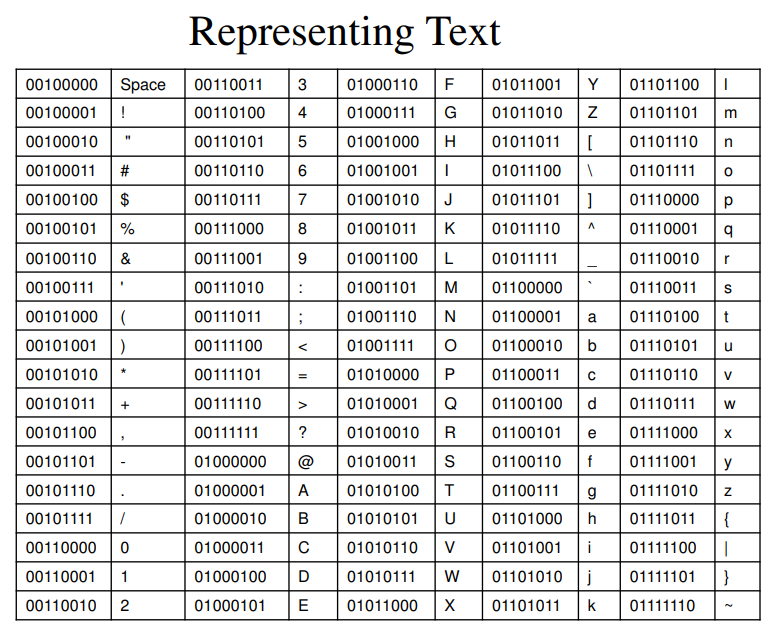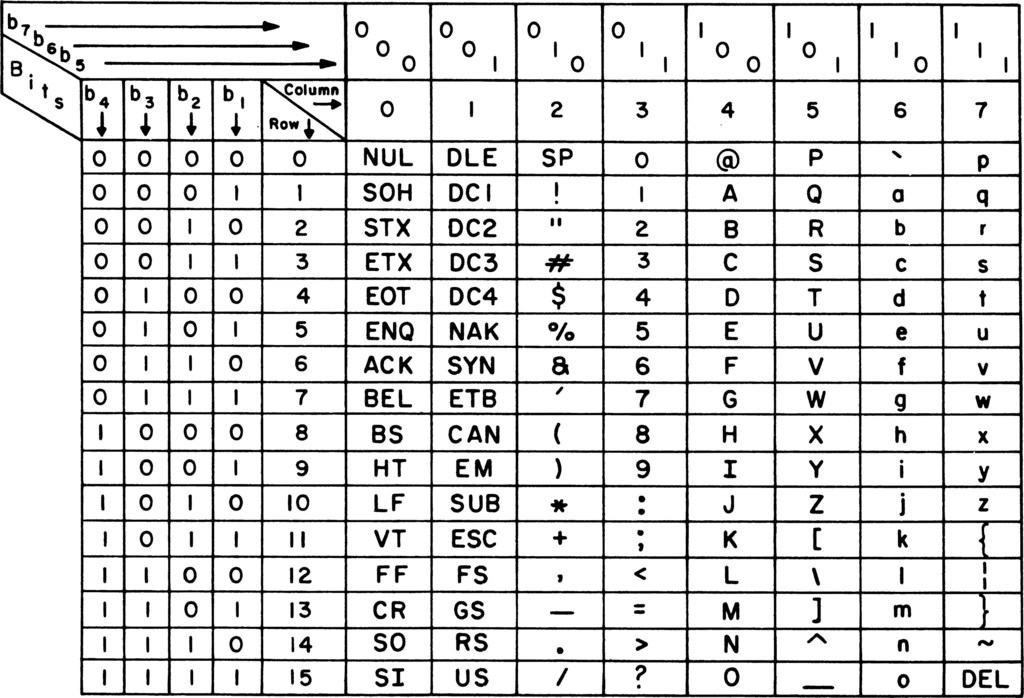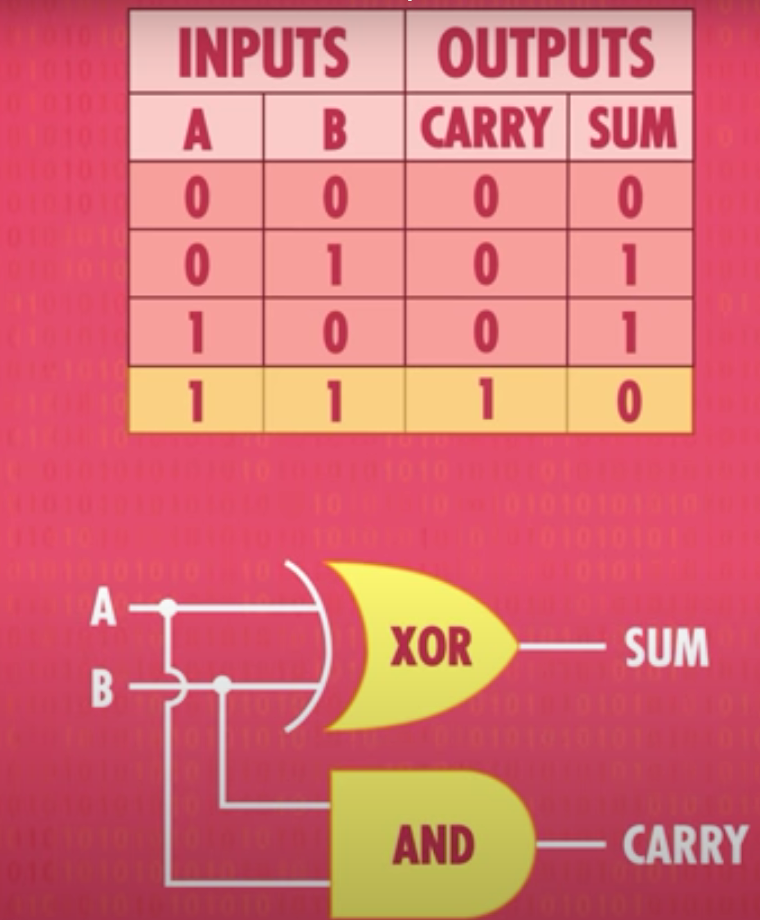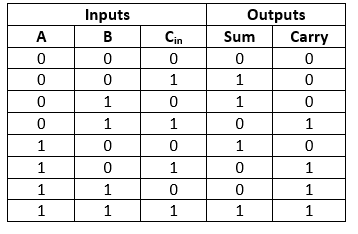Data Representation
Computer can only store bits. In order to display text or other forms of data, we need a way to use bits to represent them aka "representing data as bits".
Text as Bits
Character data is comprised of symbols and numerals that are not used in calculations. And it is commonly referred to as "text".
Examples:
- Symbols (e.g., Latin letters, chinese characters...)
- Numerals (0,1,2,3,...9)
- Unprintable characters (space, newline, tab)
Encoding
To represent characters as bit strings we need an encoding.
Character encoding is the process of assigning numbers to graphical characters, especially the written characters of human language, allowing them to be stored, transmitted, and transformed using digital computers.
Requirements:
- A set of characters to be represented.
- A length
nfor bit strings. (e.g., 7-bit ASCII char) - A mapping from characters to bit strings (one-to-one relationship).

ASCII
ASCII abbreviated from American Standard Code for Information Interchange, is a character encoding standard for electronic communication. It was designed for teleprinters.
- Letters are ordered lexicographically.
- Numbers 0-9 are ordered lexicographically.
- Related characters are organized in blocks (upper case, lower case, and numbers).
- Upper case vs. lower case is just 1 bit.
- Requires 7 bits for each character. The leftmost bit is set to 0.
- Provides 128 characters ().
ASCII Chart:

Encode "the" in ASCII:
| character | ASCII Code |
|---|---|
| t | |
| h | |
| e |
bit 1 is at the rightmost column.
Unicode
👍 Unicode is a modern system of character encoding that supports most writing systems.
- UTF-32 uses 32 bits for each character.
- UTF-16 uses one or two 16-bit strings per code point.
- UTF-8 ues between one and four 8-bit strings per code point. It is backwards compatible with 7-bit ASCII.
Use "🪟+ ." to type emoji.
Numbers as Bits
How to store numbers as bits? We can use binary numbers. Consider the following example.
Example:
Starting from position 0 (rightmost)
- 0 has a multiplier of
- 1 has a multiplier of
- 0 has a multiplier of
- 1 has a multiplier of
- Total is 10 (in base-10).
Adding Binary Numbers
We can use bit operations to build half adders and full adders to perform additions.
binary math operations - half/full adder
Half Adder
A half adder can be used to add two 1-bit numbers.

Suppose we have 1-bit binary numbers and . We want to compute the result .
Full Adder
The half adder is used to add only two numbers. To overcome this problem, the full adder was developed. The full adder is used to add three 1-bit binary numbers A, B, and carry C. The full adder has three input states and two output states i.e., sum and carry.


In general, for n-bit binary numbers and . The sum is a n+1-bit binary numbers where
Modular Arithmetic
What happen when we have a number that is too big? (e.g., exceeds 8-bit limit)
Answer: CPU will perform integer modulo where is the number of bits.
Suppose we are adding two 8-bit numbers.
10000000(128) + 10000001(129) = 100000001(257, 9-bits)
Drop the leftmost bit to get 8-bits 00000001(1).
This "dorp" action can be achieved by performing a mod on the result. is the number of bits.
2's Complement
2's complement is a method of signed number representation.
Properties of 2's complement:
- For bits, we can represent from to
- e.g., 8-bit strings, the range is ~
- If the leftmost bit is 0, then the number is positive. Otherwise, it is negative.
- Always perform after each addition.
3-bit 2's complement table:
| Bits | Unsigned value | Two's complement value |
|---|---|---|
| 000 | 0 | 0 |
| 001 | 1 | 1 |
| 010 | 2 | 2 |
| 011 | 3 | 3 |
| 100 | 4 | -4 |
| 101 | 5 | -3 |
| 110 | 6 | -2 |
| 111 | 7 | -1 |
Hexadecimal
Hexadecimal is a base-16 number system. So the numeral in position gets multiplier of .
Base-10, Base-2, and Base-16 table:
| Decimal (Base 10) | Binary (Base 2) | Hexadecimal (Base 16) |
|---|---|---|
| 0 | 0011 | 0x0 |
| 1 | 0001 | 0x1 |
| 2 | 0010 | 0x2 |
| 3 | 0011 | 0x3 |
| 4 | 0100 | 0x4 |
| 5 | 0101 | 0x5 |
| 6 | 0110 | 0x6 |
| 7 | 0111 | 0x7 |
| 8 | 1000 | 0x8 |
| 9 | 1001 | 0x9 |
| 10 | 1010 | 0xA |
| 11 | 1011 | 0xB |
| 12 | 1100 | 0xC |
| 13 | 1101 | 0xD |
| 14 | 1110 | 0xE |
| 15 | 1111 | 0xF |
Interpret Hex
Hex to base-2 string, just need to concatenate the converted strings together.
Write 4F as an 8-bit string:
4 -> 0100, F -> 1111. So 4F -> 0100 1111
Hex to base-10 number, the steps are similar to "convert base-2 to base-10"; the multiplier.
Write 4F as a base-10 number:
4 gets a multiplier of because it is in position 1. F(15) gets a multiplier of because it is in position 0.
Python
How to format integer in hex?
>>> f"{79:X}"
'4F'
>>> f"{255:X}"
'FF'
Floating Point Numbers
A floating-point number is represented approximately with a fixed number of significant digits (the significand) and scaled using an exponent in some fixed base; the base for the scaling is normally two.
-- wikipedia
